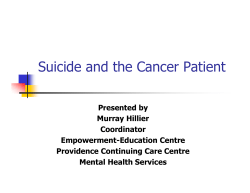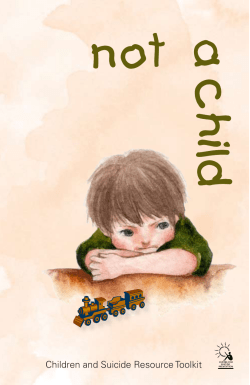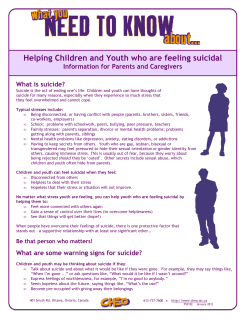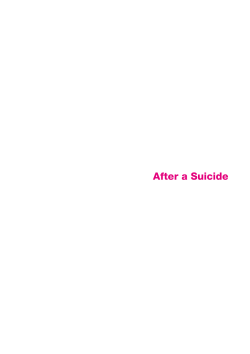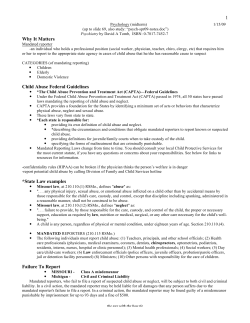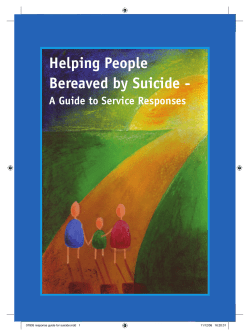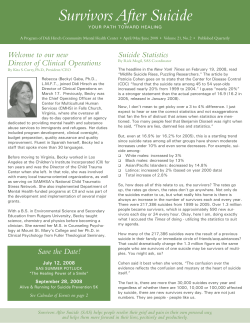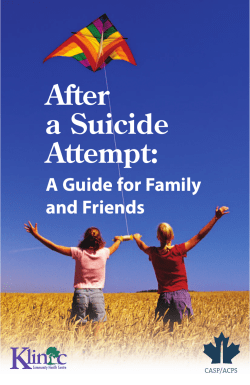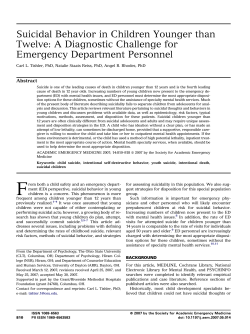
Preventing Suicide in Children and Youth
Quarterly Children’s Mental Health Research Catch us on video! Vo l . 3 , N o. 4 2 0 0 9 Preventing Suicide in Children and Youth Overview Children’s Health Policy Centre Review NEW ! Soon you’ll be able to see this and future issues of the Quarterly on video on our website. To help us launch the first video, please email your questions on child and youth suicide no later than November 15 to chpc_quarterly@sfu.ca. Your questions will be considered for incorporation in the video. As well, we will notify all subscribers by email when the video has been posted to our website. Next Issue Even one is one too many Feature Reducing youth suicide: What works? Letters Obesity is a serious public health problem with both environmental and biological causes. In recent years the incidence of childhood obesity has increased dramatically. We investigate this trend and the implications for children’s mental health in our Winter 2010 issue. About the Children’s Health Policy Centre Native youth suicide: Behind the statistics Expressing needs, supporting families As an interdisciplinary research group in the Faculty of Health Sciences at Simon Fraser University, we aim to connect research and policy to improve children’s social and emotional well-being, or children’s mental health. We advocate the following public health strategy for children’s mental health: addressing the determinants of health; preventing disorders in children at risk; promoting effective treatments for children with disorders; and monitoring outcomes for all children. To learn more about our work, please see www.childhealthpolicy.sfu.ca Children’s Mental Health Research Quarterly Vol. 3, No. 4 | © 2009 Children’s Health Policy Centre, Simon Fraser University Children’s Health Policy Centre Quarterly This Issue V ol . 3 , N o, 4 2 0 0 9 About the Quarterly Overview The Quarterly is a resource for policy-makers, practitioners, families and community members. Its goal is to communicate new research to inform policy and practice in children’s mental health. The publication is funded by the British Columbia Ministry of Children and Family Development, and topics are chosen in consultation with policymakers in the Ministry’s Child and Youth Mental Health Branch. Even one is one too many Quarterly Team Scientific Writer Christine Schwartz, PhD, RPsych Scientific Editor Charlotte Waddell, MSc, MD, CCFP, FRCPC Research Assistants Jen Barican, BA, Orion Garland, BA & Larry Nightingale, LibTech 3 Some 256 young people’s lives are lost to suicide every year in Canada. We outline who is at risk, how we can intervene, and what factors best protect young people from this tragedy. Review 8 Reducing youth suicide: What works? Researchers have recently completed high-quality evaluations of four suicide prevention and treatment programs. We present their results, including those from a universal prevention program called SOS that has been shown to be particularly effective. Feature 13 Native youth suicide: Behind the statistics Production Editor Daphne Gray-Grant, BA (Hon) While some aboriginal communities have suicides rates as much as 800 times the national average, more than half had no youth suicides at all between 1987 and 2000. We explore explanations for these dramatic differences. Copy Editor Naomi Pauls, BA, MPub Letters 15 Expressing needs, supporting families Contact Us We hope you enjoy this issue. We welcome your letters and suggestions for future topics. Please email them to chpc_quarterly@sfu.ca or write to the Children’s Health Policy Centre, Attn: Daphne Gray-Grant, Faculty of Health Sciences, Simon Fraser University, Room 2435, 515 West Hastings St., Vancouver, British Columbia V6B 5K3 Telephone (778) 782-7772 A reader asks how family interactions may affect children and youth with schizophrenia. If you have a question or comment, please be sure to contact us by email or by regular post. Appendix 17 Research methods References 18 We provide all references cited in this edition of the Quarterly. Links to Past Issues 24 How to Cite the Quarterly We encourage you to share the Quarterly with others and we welcome its use as a reference (for example, in preparing educational materials for parents or community groups). Please cite this issue as follows: Schwartz, C., Waddell, C., Barican, J., Garland, O., Nightingale, L., & Gray-Grant, D. (2009). Preventing suicide in children and youth. Children’s Mental Health Research Quarterly, 3(4), 1–24. Vancouver, BC: Children’s Health Policy Centre, Faculty of Health Sciences, Simon Fraser University. Children’s Mental Health Research Quarterly Vol. 3, No. 4 | © 2009 Children’s Health Policy Centre, Simon Fraser University Overview Even one is one too many “It’s like being churned underneath a giant wave spinning, turning, flipping with no idea which way the surface is and struggling to breathe all the while.”1 These words were written by a youth who committed suicide. The isolation and hopelessness expressed above echo many of the experiences and feelings of the 81 children and youth who committed suicide in British Columbia between 2003 and 2007.1 Suicide is second only to motor vehicle accidents as a leading cause of death for young people aged 12 to 18 in BC.1 Similar losses occur countrywide. In Canada, two in every 100,000 children aged 10 to 14 commit suicide annually.2 For youth aged 15 to 19, this rate is even higher, at 10 in every 100,000.2 These statistics translate into 256 young lives lost to suicide every year in Canada.2 As well, for every young person who commits suicide, many more attempt it or contemplate it.3 Rates are a quantitative way of describing the impact of suicide at the population level. At the individual level, however, the impact is tragic in a way that numbers cannot express –– for young people and for their families and communities. Even one child’s life lost to suicide is one too many. Fortunately, there are effective ways to prevent suicide in populations of young people, as well as effective ways to respond to individuals at risk. Such interventions are featured in our Review article. Suicide is second only to motor vehicle accidents as a leading cause of death for young people aged 12 to 18 in BC. Who is at risk? One of the most important risk factors for suicide is the presence of an untreated mental disorder. This applies to as many as 90% of adolescent suicide victims at the time of their death.4 Depression is particularly common, occurring in 60% of youth suicide victims and in 40–80% of youth who experience suicidal thoughts or attempts.5 Substance abuse and conduct disorder are also frequent in youth who commit suicide, especially boys.4 Clearly, to reduce suicide in young people, it is vital to prevent and treat these mental disorders. Previous suicide attempts are also an important risk factor for future attempts.1 The risk is highest within the first six months after an initial attempt, when 15% of youth go on to make another attempt.6 Consequently, it is always necessary to thoroughly investigate and address the issues that lead to any suicide attempt in a young person. Children’s Mental Health Research Quarterly Vol. 3, No. 4 | © 2009 Children’s Health Policy Centre, Simon Fraser University Overview continued For young people, suicide attempts often follow difficult life events. For example, a review in BC found that 68% of children and youth who committed suicide had recently experienced adverse events causing significant emotional distress.1 These events can range from serious conflict with parents or romantic partners to legal crises to more chronic familial dysfunction, such as abuse and neglect.1, 7 However, such events are rarely the sole cause of an attempt. More typically, stressful life events precipitate suicide attempts in young people who are already at risk because of untreated mental disorders,4 including depression, substance abuse and conduct disorder.8–11 It is always crucial to identify and address serious and preventable adverse events — such as abuse, neglect, discrimination and residential instability.1, 3, 7 Notably, many of these adverse events are also risk factors for developing mental disorders that are linked to suicide. Therefore, when young people are protected from such experiences, their risk for developing a mental disorder declines. This, in turn, reduces their suicide risk. When young people are raised in healthy and supportive family environments and attend well-run schools within safe communities, their suicide risk is greatly reduced. What protects young people? In general, it appears that the same conditions that contribute to healthy child development can also protect children and youth from suicide. When young people are raised in healthy and supportive family environments and attend well-run schools within safe communities, their suicide risk is greatly reduced.3, 12, 13 As well, one study of Native American youth demonstrated that increasing protective factors was more effective than decreasing risk factors in reducing suicide.7 Table 1 outlines specific protective factors that have been correlated with reducing suicide in children and youth. Table 1: Factors that protect children and youth from suicide Individual Factors High “emotional intelligence”14 High self-esteem15 High personal control15 Good problem-solving & coping skills15 High academic achievement12, 16 Positive mood & emotional health 7, 17 Family Factors Positive family relationships18 High levels of family cohesion & support 7, 12, 13, 15, 16, 19 Frequent engagement in shared activities 12, 13 Good parental supervision12, 19 High parental expectations for academics & behaviour 12 Strong parental disapproval of antisocial behaviours17 Community Factors Positive connections to school3, 12, 16 Good school attendance19 Available teachers perceived as fair 13 Available counsellors or nurses in the school 7 Good presence of supportive peers 7, 13, 15, 19 Frequent extracurricular activities 3 Strong involvement in a faith community 7, 18 Safe neighbourhoods 13 Children’s Mental Health Research Quarterly Vol. 3, No. 4 | © 2009 Children’s Health Policy Centre, Simon Fraser University Overview continued How can we best intervene? By understanding risk and protective factors, we are better able to prevent suicide. For example, prevention programs that take these factors into consideration are much more likely to be effective.20 School-based prevention programs are among the most common. Some of these programs have been universal, delivered to all the young people in a given population, while others have been targeted to those most at risk. The outcome research on these prevention programs has been mixed.21 Our Review article features an in-depth look at outcomes from the most recent school-based prevention studies. There are also community-based suicide prevention programs that appear promising. One of these is a program that teaches journalists to report the news in a manner that reduces the likelihood of imitative suicides. In Austria, for example, overall suicide rates declined nearly 20% over a fouryear follow-up period after preventive media guidelines were introduced.18 (Unfortunately, the evaluations of this program did not meet our selection criteria so it is not featured in our Review.) More recently, the Canadian Psychiatric Association published media guidelines for reporting suicide, although their impact has yet to be evaluated.22 For practitioners interested in additional resources on preventing youth suicide, the British Columbia Ministry of Children and Family Development’s Child and Youth Mental Health Branch has compiled helpful web-based tools. Identifying individuals at risk Although prevention programs can reach large populations of children, accurately identifying individuals who are at risk is also key.23 To meet this objective, school-based screening programs are commonly used to reach large numbers of young people. Such screening programs can have added benefits beyond identifying at-risk students. For example, a large randomized controlled study of American high-school students found that a suicide screening program actually reduced distress in depressed youth.23 Other attempts to identify at-risk young people involve “gatekeeper” training programs. Adults in these interventions — usually teachers, counsellors, coaches or police — are taught to recognize risk factors, identify high-risk individuals and refer these youth to appropriate services. A recent review found that Canadian and American versions of these programs had a positive impact on gatekeepers’ skills, knowledge and attitudes.24 The effectiveness of these programs in decreasing actual rates of suicidal ideation or attempts has yet to be determined.24 Given the potential benefits, however, the BC Coroners Service recently recommended a province-wide evaluation of gatekeeper training programs.25 Children’s Mental Health Research Quarterly Vol. 3, No. 4 | © 2009 Children’s Health Policy Centre, Simon Fraser University Overview continued From identification to evaluation Once a young person has been identified as being at risk, it is essential that they receive an individual clinical evaluation. The evaluation should assess risk level, including the circumstances motivating the thoughts of suicide, the methods being considered, the degree of planning and the access to potential means.4 A thorough assessment will also evaluate mental status and diagnose any underlying mental disorders. As well, by examining the young person’s social circumstances, protective factors such as healthy family functioning and supportive peer relationships can be identified and enhanced. It is this kind of careful evaluation that leads to the most effective individual intervention plans. Managing safety concerns All suicidal young people require a plan to minimize risks and ensure adequate adult support and supervision. Obviously, it is critical to restrict access to potential means of suicide, such as medications and firearms. As well, the availability of alcohol and other disinhibiting substances should be restricted.21 Other community-wide efforts can be made to restrict access to the means of self-harm. For example, the BC Coroners Service recommended that the five bridges in BC involved in 50% of suicide deaths by jumping be outfitted with barriers to prevent suicide.25 At-risk young people are often encouraged to sign “contracts” promising to not engage in suicidal behaviour. However, there are no empirical studies on the effectiveness of this strategy.21 Similarly, there is no research evidence on the usefulness of telephone crisis hotlines.18 If safety cannot be assured, an adult should immediately accompany the young person to the nearest emergency room. If short-term hospitalization is necessary, careful discharge planning is essential to ensure that risk factors have been addressed and that there is follow-up with a qualified mental health practitioner.21 Programs for preventing mental disorders can save lives and have a lasting impact on suicide rates. Reducing risk longer term Once acute risks are addressed and immediate safety is ensured, longerterm interventions can be considered. A number of treatments have been developed to specifically reduce suicidal thinking and behaviours among youth who have made previous suicide attempts. Longer term, it is also imperative to accurately diagnose and effectively treat any underlying mental disorders. For example, treating depressed Children’s Mental Health Research Quarterly Vol. 3, No. 4 | © 2009 Children’s Health Policy Centre, Simon Fraser University Overview continued youth with cognitive-behavioural therapy (CBT) and the antidepressant medication fluoxetine (brand name Prozac) has been found to significantly reduce suicidal ideation.26 Similarly, youth who received CBT and relapse prevention aftercare for alcohol abuse had significantly lower rates of suicidal ideation, even though the intervention did not specifically address suicide.27 For more information on effective treatments for specific mental disorders in children and youth, please see previous issues of the Quarterly and our research reports. An ounce of prevention is priceless Message on the bottle: The unintended outcomes In June 2004, Health Canada issued warnings that certain antidepressant medications had the potential to increase suicidal thoughts and behaviours in children and youth. These medications included selective serotonin reuptake inhibitors, or SSRIs, as well as selective norepinephrine reuptake inhibitors.28–35 Warnings were given for nine medications available under the following trade names: Celexa, Effexor, Luvox, Paxil, Prozac, Remeron, Wellbutrin, Zoloft and Zyban. Regulatory bodies in other countries issued similar warnings. After these warnings were issued, antidepressant prescriptions for children and youth declined markedly in the Netherlands,36 the United Kingdom,37 the United States36 and parts of Canada.38 Researchers were then concerned about the potential for increased suicides due to untreated (or undertreated) depression. In the UK, decreased antidepressant prescription rates have not been linked to increased suicidal behaviour in young people.37 In contrast, data from Canada, the Netherlands and the US suggest a significant correlation between decreased antidepressant prescription rates and increased suicide rates.36, 38 For example, antidepressant prescription rates for children and youth in Manitoba decreased by 14% while suicide rates rose by 25% in the two years following these warnings.38 On balance, most research continues to support the use of SSRIs in treating adolescent depression.39 Of these medications, fluoxetine (brand name Prozac) has a particularly strong efficacy and safety profile.40 As with any psychotropic medications being used by young people, careful individual monitoring is essential. As well, there is a need for long-term public health monitoring of medication safety and efficacy in young people. Notably, there is also evidence that preventing certain mental disorders reduces suicide risk. For example, in youth at risk for depression, those who received group CBT showed significantly less suicidality after two years than youth who received only “usual” care (which included accessing any available health care services).41 As well, first graders who received a universal classroom intervention designed to decrease aggression — The Good Behavior Game — showed half the rates of suicidal ideation and attempts by the time they reached adulthood, compared to children who did not receive the intervention.42 These data strongly suggest that programs for preventing mental disorders can save lives and have a lasting impact on suicide rates. Such prevention programs should therefore be an essential component of any public health strategy for addressing suicide. This is also the repeated message of the BC Coroners Service –– that most child and youth suicides are preventable.1 Children’s Mental Health Research Quarterly Vol. 3, No. 4 | © 2009 Children’s Health Policy Centre, Simon Fraser University Review Reducing youth suicide: What works? T o date, interventions to reduce youth suicide have included large-scale (primary) prevention programs as well as targeted treatments (or secondary prevention) for young people who have attempted suicide. Here we identify and summarize the research conducted over the past five years on these two types of interventions. (For a review covering the research prior to this, please see our 2005 report on preventing suicide in youth.) Finding the best studies Of the 36 articles we retrieved for assessment, five articles describing four randomized controlled trial (RCT) evaluations met our inclusion criteria. (See Appendix for a full description of our methods.) Two articles described an evaluation of a universal prevention program called Signs of Suicide (SOS).43, 44 This program was aimed at American highschool students. Additional information on interventions and participants is provided in Table 2. SOS participants were 37% less likely to report a suicide attempt in the past three months than youth in the control group. Table 2: Prevention and treatment interventions for reducing suicide Interventions Control/Comparisons Description (Number of participants) Description (Number of participants) Children Age range Gender Prevention Signs of Suicide (SOS): 44 2-day high-school-based program led by school No-intervention control (2,094) staff using video & classroom discussions to increase knowledge of suicide, depression & helpful responses to risk, along with screening for depression & suicide (2,039) Not reported 52% female Treatment Multisystemic Therapy (MST): 45, 47 4-month home-based family-centred therapy including safety planning, helping parents provide monitoring & structure, & encouraging youth to disengage from troubled peers (79) Hospitalization including a behavioural milieu program & aftercare plan (81) Skills-Based Treatment (SBT): 6 6-month therapy including 9 individual sessions & 1 family session on problem-solving & mood management skills, including cognitive restructuring & relaxation practice in session & as homework (15) Supportive Relationship Treatment 12 –17 including unstructured sessions encouraging 82% female affect & its connection to events (16) Youth-Nominated Support Team (YST): 46 6-month weekly contact with up to 4 youth-nominated support persons* who received information on youth’s psychiatric disorder, treatment plan & suicide risk factors along with communication training (151) Hospitalization including psychotherapy & medication (138) * Support people included parents, relatives, family friends, school staff and peers. Children’s Mental Health Research Quarterly Vol. 3, No. 4 | © 2009 Children’s Health Policy Centre, Simon Fraser University 10 –17 35% female 12 –17 68% female Review continued Three other articles described evaluations of three treatments — Multisystemic Therapy (MST),45 Skills-Based Treatment (SBT)6 and YouthNominated Support Team (YST).46 These treatments were all aimed at high-risk (hospitalized) American youth. All SBT youth had made a suicide attempt, and all YST youth had either made an attempt or expressed significant ideation. In contrast, 49% of the MST youth were hospitalized for reasons other than suicidality, including psychosis and threatening to harm others.45 MST also differed from the other treatments in that it was originally developed to treat antisocial behaviour and then was modified to address psychiatric crises, including suicide risk.45 Preventing suicide The sole prevention trial — SOS — effectively averted suicide attempts in large groups of American high-school students who were ethnically, geographically and economically diverse. SOS participants were 37% less likely to report a suicide attempt in the past three months than youth in the control group.44 SOS participants also had greater knowledge and more helpful attitudes about suicide and depression.44 The program was not effective, however, at reducing suicidal thoughts or at increasing help-seeking behaviours such as talking to an adult or obtaining treatment for suicide or depression (as shown in Table 3). Table 3: Suicide-related outcomes Intervention Significant Outcomes* Non-significant Outcomes SOS youth had fewer suicide attempts (3% vs. 5%) SOS youth had more knowledge/adaptive attitudes about suicide & depression Suicidal ideation Help-seeking behaviours Multisystemic Therapy (MST) 45, 48 compared to treatment-as-usual hospitalization at 12-month follow-up MST youth had fewer suicide attempts (pretreatment to follow-up declines of 31% to 4% vs. 19% to 4%) Parent-reported suicide attempts** (9% vs. 17%) Suicidal ideation Skills-Based Treatment (SBT) 6 compared to Supportive Relationship Treatment at 6-month follow-up None Suicide attempts† (27% vs. 13%) Suicidal ideation Youth-Nominated Support Team (YST) 46 compared to treatment-as-usual hospitalization at the end of treatment YST girls who completed treatment‡ had lower suicidal ideation YST girls improved significantly more on parent-rated mood/self-harm Suicide attempts for entire sample (17% vs. 12%) Parent-rated mood/self-harm for entire sample Prevention Signs of Suicide (SOS) 44 compared to no-intervention control at 3-month follow-up Treatment All rates are based on youth self-reports unless otherwise specified. Suicide attempt percentage data list intervention groups followed by comparison/control groups. * Significant at p≤.05. ** For both entire sample and subsample of youth who engaged in self-harming behaviour prior to treatment. † Measured at end of treatment not 6-month follow-up. ‡ Treatment completion defined as having at least 2 support persons for at least 3 months. Children’s Mental Health Research Quarterly Vol. 3, No. 4 | © 2009 Children’s Health Policy Centre, Simon Fraser University Review continued Treating the most vulnerable The success of the treatment programs varied. MST youth had statistically significant reductions in suicide attempts one year after treatment compared to youth who were hospitalized but received no MST (based on youth selfreport but not by parents’ reports).45 However, given that 4% of MST youth and 4% of comparison (hospitalized-only) youth had a suicide attempt within the one-year follow-up period, the statistically significant benefit for MST youth was likely due to their much higher pre-intervention base rates of attempting suicide (31% for MST youth compared to 19% for hospitalizedonly youth).45 The results of YST varied significantly by gender. YST failed to produce any improvements in suicide-related outcomes for boys. However, based on parent ratings of mood and self-harm, YST girls improved significantly more than comparison (hospitalized-only) girls. As well, YST girls who had contact with two or more support people for three months or more had less suicidal ideation than comparison girls.46 Gender differences regarding the importance of social support likely underlie these differing outcomes for boys and girls. For example, the authors cited previous research highlighting the particular value of emotional support for girls and their tendency to be more satisfied with such support than boys. Of the three treatments, only SBT failed to produce any significant improvements over the comparison intervention — supportive unstructured therapy — for any suicide-related outcome. Youth in both groups had similar reductions in suicidal ideation, with approximately 76% of all study participants falling within the “non-clinical range” at the end of treatment (without a statistically significant difference between SBT and control youth).6 There is solid evidence that suicide rates can be significantly reduced by prevention programs. Are there other treatment benefits? The three treatment evaluations also assessed potential benefits beyond suicidal thoughts and attempts. MST produced significant behavioural changes, including parents reporting more control over their children’s behaviour 45 and youth reporting more rules to follow.47 However, none of the study treatments produced any added benefits regarding depressive symptoms,6, 45, 46 hopelessness,45 emotional distress,47 internalizing 46, 47 and externalizing symptoms,47 self-esteem,47 problem-solving skills,6 anger,6 family functioning,47 school attendance47 or out-of-home placements.47 10 Children’s Mental Health Research Quarterly Vol. 3, No. 4 | © 2009 Children’s Health Policy Centre, Simon Fraser University Review continued Prevention prevails Investments in effective suicide prevention programs could have life-saving outcomes for highschool students. There is solid evidence that suicide rates can be significantly reduced by prevention programs. In particular, the universal program SOS has been shown to prevent suicide in large and diverse groups of high-school students. It is especially encouraging that this program had such a large effect size –– SOS youth were 37% less likely to attempt suicide than comparison youth –– given that SOS was delivered in only two days by school staff. As well, because SOS teaches youth how to respond to suicidal peers, the program may even prevent deaths beyond the direct participants, given that youth who commit suicide are more likely to discuss their plans with a friend than with an adult.1 The results of the three treatment studies were less compelling. However, their less dramatic results may have been affected by methodological limitations in their evaluations. Because of small sample sizes and because of the rarity of suicide attempts, the likelihood of finding statistically significant differences between treatment and comparison groups was extremely limited. As well, because these treatments were compared to other treatments (rather than to no interventions, as was done in the SOS prevention study), it was likely far more difficult to find statistically significant differences in outcomes. Children’s Mental Health Research Quarterly Vol. 3, No. 4 | © 2009 Children’s Health Policy Centre, Simon Fraser University 11 Review continued Life-saving policy and practice Learning how to ACT The Signs of Suicide (SOS) program, which is delivered by school staff, teaches There is evidence that some suicidal youth to recognize signs of suicide, to treat them as an emergency and young people benefit from the to respond to them effectively. This is achieved by using the video Friends targeted treatments Multisystemic for Life, which dramatizes signs of suicidality and depression and includes interviews with people whose lives have been affected by suicide. The video Therapy (MST), Skills-Based Treatment also teaches the ACT acronym: ACKNOWLEDGE the signs of suicide and take (SBT) and Youth-Nominated Support them seriously; let the person know you CARE and want to help; then, TELL Team (YST). A thorough individual a responsible adult. As well, youth anonymously complete a depression assessment helps determine which and suicide screening measure. High-scoring youth are encouraged to seek specific interventions are most likely help immediately.44 Staff are trained to deliver SOS by receiving practice to help. It also facilitates the creation guidelines and a training video for $300 US for 300 students per year. of an individualized plan to address An additional electronic kit (for $75 US) provides the right to reproduce materials for an unlimited number of students. additional risk factors, such as mental To learn more about SOS, including how to obtain program materials, go disorders or abuse and neglect. to www.mentalhealthscreening.org/schools/index.aspx The results of this review strongly suggest that investments in effective suicide prevention programs could have life-saving outcomes for highschool students. The prevention program Signs of Suicide (SOS) is effective. It is also a brief program that can be delivered in high-school classrooms by school staff. As well, it has been tested in both suburban and inner city communities. Therefore SOS’s dissemination and maintenance potential is very strong. To date, however, SOS has only been evaluated in American settings. Canadian evaluations are strongly warranted to determine whether the positive results can be replicated here. Beyond evaluating SOS in Canadian high-school students, our review uncovered a need for new prevention studies, particularly in younger populations. Such studies could examine interventions aimed at positively influencing modifiable risk and protective factors much earlier in children’s development. 12 Children’s Mental Health Research Quarterly Vol. 3, No. 4 | © 2009 Children’s Health Policy Centre, Simon Fraser University Feature Native youth suicide: Behind the statistics I n BC, the adolescent suicide rate is 5 to 20 times higher in aboriginal youth compared with non-aboriginal youth.49 However, these figures are misleading because they obscure the dramatically different suicide rates across the 197 formally identified First Nations “bands” within the province.50 For example, while some aboriginal communities have suicide rates as much as 800 times the national average, more than half had no youth suicides at all between 1987 and 2000.49 To help understand these striking differences in suicide rates, researchers Chandler and Lalonde50 examined youth suicides in BC aboriginal communities over 14 years, beginning in 1987. Rather than focusing on individual factors in the lives of the youth who committed suicide, these researchers attempted to assess cultural continuity — community-level efforts “to preserve their cultural pasts and to secure future control of their civic lives.” 50 How culture makes a difference Eight cultural-continuity variables are detailed in Table 4. Each variable was measured using federal and provincial public data sources along with information provided by local community agencies.50 Every variable was deemed “present” or “absent” (or measured dichotomously), except for children in foster care, which was measured as a proportion (or as a continuous variable). Cultural continuity is one of the strongest factors reducing the risk of suicide in aboriginal youth. Table 4: Community cultural-continuity variables 50, 51 The community is part of a band that has institutions of self-government which provide substantial economic & political independence. Women form the majority of local government members.* The community is part of a band that has a long history of land claims actions. The community has one (or more) building(s) that are specifically designated or reserved for cultural activities. The community controls child custody & protection services & there is a lower proportion of children removed from parental care. The majority of students in the community attend a band-administered school. The community has a high level of control over the administration of health services. The community owns or controls police & fire services. * Women’s participation in local government was assessed given the historically matrilineal structure of Canadian West Coast First Nations. Children’s Mental Health Research Quarterly Vol. 3, No. 4 | © 2009 Children’s Health Policy Centre, Simon Fraser University 13 Feature continued Each of the eight variables was associated with lower rates of youth suicide. The reduction in relative suicide risk was calculated for six variables (as shown in Table 5). Self-government emerged as the strongest protective factor.51 It was also strongly related to the presence of other culturalcontinuity factors within each community.50 Collectively, the more variables that were present in a community, the lower the suicide rate. Table 5: Relative suicide risk reduction for six community variables 51 Community Variable Relative Risk Reduction Successful efforts to attain self-government 85% Local control of education 52% History of pursuing land claims 41% Local control of health services 29% Presence of cultural facilities 23% Local control of police & fire services 20% Strikingly, communities with all eight factors had no youth suicides, while communities with no factors had rates more than 10 times the national average.50 These data show that some aboriginal communities in fact have lower suicide rates than many non-aboriginal communities. Importantly, the percentage of children in foster care was also significantly higher in communities that experienced suicides than in communities that did not.50 In contrast to commonly held assumptions, however, socio-economic status, geographic remoteness and population density were unrelated to suicide among First Nations youth.50, 51 Overall, these data strongly suggest that cultural continuity is one of the strongest factors reducing the risk of suicide in aboriginal youth. Connecting to the past to strengthen the future These studies clearly demonstrate the importance of preserving and promoting First Nations’ cultural heritage as a means of protecting aboriginal young people from suicide.52 These studies also show that some of the factors protecting or jeopardizing aboriginal young people –– such as selfgovernment or foster care –– are modifiable and therefore can be addressed. 14 These studies clearly demonstrate the importance of preserving and promoting First Nations’ cultural heritage as a means of protecting aboriginal young people from suicide. Children’s Mental Health Research Quarterly Vol. 3, No. 4 | © 2009 Children’s Health Policy Centre, Simon Fraser University Letters Expressing needs, supporting families To the Editors: Your recent issue mentioned important information regarding what is known about the causes of schizophrenia, including solid evidence that parenting practices are not responsible for the disorder. However, your article did not mention the research on the influence of family functioning on the course of schizophrenia. In particular, high levels of expressed emotion within families have been associated with poorer outcomes. Can you comment on expressed emotion and clinical outcomes for children and youth with schizophrenia? Roxanne Still Victoria, BC The term expressed emotion, or EE, derived from research on the family environments of adults with schizophrenia. Measures of EE typically assess criticism, hostility and emotional overinvolvement, as well as warmth and positivity displayed by family members.53 Family members assessed as having “low” EE are typically tolerant and sensitive to the individual’s needs, whereas those with “high” EE are prone to using inflexible coping strategies and to being intrusive.53 That said, the vast majority of high-EE relatives are highly motivated to help their family members and are very involved in their care.54 Although strong correlations between high EE and adult schizophrenia relapse rates have been long documented,53 data on children and youth are extremely limited. We uncovered only one relevant study, which included 26 youth at “imminent” risk for psychosis and their caregivers. As expected, higher levels of parental positivity and warmth (i.e., low EE) were associated with fewer psychotic symptoms and enhanced social functioning.55 Surprisingly, high levels of emotional overinvolvement among parents (i.e., high EE) were also correlated with fewer symptoms and enhanced social functioning among youth.55 In explaining this unanticipated finding, the authors suggested that optimal levels of emotional involvement differ over the lifespan. In other words, while parental “overinvolvement” may be negative for adults with schizophrenia, it may actually serve to positively support and protect younger people. Children’s Mental Health Research Quarterly Vol. 3, No. 4 | © 2009 Children’s Health Policy Centre, Simon Fraser University 15 Letters continued Because caring for a child with psychosis is extraordinarily difficult, we urge practitioners to understand the significant support that parents require. Many families benefit from participating in online or in-person support groups. Parents also need practical assistance, such as respite from caregiving duties. Finally, families need information about psychosis, including typical symptoms and their causes. Such information can help correct misperceptions that have been associated with high-EE levels, such as beliefs that symptoms and challenging behaviours are under individual control rather than being due to the illness.53 16 The Schizophrenia Society of Canada — www.schizophrenia.ca — provides helpful information regarding supports for families, including links to local organizations. Children’s Mental Health Research Quarterly Vol. 3, No. 4 | © 2009 Children’s Health Policy Centre, Simon Fraser University Appendix Research methods For our review, we used systematic methods adapted from the Cochrane Collaboration.56 We limited our search to randomized controlled trials published in peer-reviewed scientific journals. To identify high-quality studies, we first applied the following search strategy: Sources • Medline, PsycINFO, CINAHL, ERIC & the Suicide Information & Education Centre Catalogue Search Terms • Suicide and prevention, treatment or intervention Limits • English-language articles published from 2004 through June 2009* • Child participants (age 0–18 years) * We limited our search to five years given that our previous report Preventing Suicide in Youth: Taking Action with Imperfect Knowledge 57 included publications prior to 2004. As well, we identified and hand-searched previously published systematic reviews on the prevention of suicide and the treatment of suicidal behaviours to find any additional relevant studies. Next, we applied the following criteria to ensure we included only the highest-quality pertinent studies: • Interventions specifically aimed at preventing or treating suicidal thoughts or attempts* • Clear descriptions of participant characteristics, settings and interventions • Random assignment of participants to intervention and control/ comparison groups at study outset • Maximum attrition rates of 20% or use of intention-to-treat analysis • Outcome measures included suicidal thoughts or attempts • Levels of statistical significance reported for suicide outcomes based on intervention assignment * We excluded interventions that only addressed risk factors for suicide, including those targeting substance abuse, depression or self-harming behaviours (such as cutting without having suicidal intentions). Two different team members then assessed each retrieved study to ensure accuracy. Children’s Mental Health Research Quarterly Vol. 3, No. 4 | © 2009 Children’s Health Policy Centre, Simon Fraser University 17 References BC government staff can access original articles from BC’s Health and Human Services Library. 1. British Columbia. Child Death Review Unit. (2008). “Looking for something to look forward to...”: A five-year retrospective review of child and youth suicide in B.C. Victoria, BC: BC Coroners Service. 2. Canada. Statistics Canada. (2009). Table 102-0551: Suicides and suicide rate, by sex and by age group (both sexes). Retrieved June 22, 2009, from http://www40.statcan.gc.ca/cbin/sf01.cgi?se=suicide&searchbut01=Go& mod=cst&lan=eng 3. Smith, A., Stewart, D., Peled, M., Poon, C., Saewyc, E., & the McCreary Centre Society. (2009). A picture of health: Highlights from the 2008 BC Adolescent Health Survey. Vancouver, BC: McCreary Centre Society. 4. Shaffer, D., Pfeffer, C. R., & the Work Group on Quality Issues. (2001). Practice parameter for the assessment and treatment of children and adolescents with suicidal behavior. Journal of the American Academy of Child and Adolescent Psychiatry, 40 (Suppl. 7), 24S–51S. 5. Barbe, R. P., Bridge, J., Birmaher, B., Kolko, D., & Brent, D. A. (2004). Suicidality and its relationship to treatment outcome in depressed adolescents. Suicide and Life-Threatening Behavior, 34, 44–55. 6. Donaldson, D., Spirito, A., & Esposito-Smythers, C. (2005). Treatment for adolescents following a suicide attempt: Results of a pilot trial. Journal of the American Academy of Child and Adolescent Psychiatry, 44, 113–120. 7. Steele, M. M., & Doey, T. (2007). Suicidal behaviour in children and adolescents. Part 1: Etiology and risk factors. Canadian Journal of Psychiatry, 52 (Suppl. 1), 21S–33S. 8. Cicchetti, D., Rogosch, F. A., & Sturge-Apple, M. L. (2007). Interactions of child maltreatment and serotonin transporter and monoamine oxidase A polymorphisms: Depressive symptomatology among adolescents from low socioeconomic status backgrounds. Development and Psychopathology, 19, 1161–1180. 9. Cicchetti, D., & Toth, S. L. (2005). Child maltreatment. Annual Review of Clinical Psychology, 1, 409–438. 10.Holmes, S. E., Slaughter, J. R., & Kashani, J. (2001). Risk factors in childhood that lead to the development of conduct disorder and antisocial personality disorder. Child Psychiatry and Human Development, 31, 183–193. 11.Bukstein, O. G., Bernet, W., Arnold, V., Beitchman, J., Shaw, J., Benson, R. S., et al. (2005). Practice parameter for the assessment and treatment of children and adolescents with substance use disorders. Journal of the American Academy of Child and Adolescent Psychiatry, 44, 609–621. 18 Children’s Mental Health Research Quarterly Vol. 3, No. 4 | © 2009 Children’s Health Policy Centre, Simon Fraser University References continued 12.Bridge, J. A., Goldstein, T. R., & Brent, D. A. (2006). Adolescent suicide and suicidal behavior. Journal of Child Psychology and Psychiatry and Allied Disciplines, 47, 372–394. 13.Fleming, T. M., Merry, S. N., Robinson, E. M., Denny, S. J., & Watson, P. D. (2007). Self-reported suicide attempts and associated risk and protective factors among secondary school students in New Zealand. Australian and New Zealand Journal of Psychiatry, 41, 213–221. 14.Cha, C., & Nock, M. (2009). Emotional intelligence is a protective factor for suicidal behavior. Journal of the American Academy of Child and Adolescent Psychiatry, 48, 422–430. 15.Walsh, E., & Eggert, L. L. (2007). Suicide risk and protective factors among youth experiencing school difficulties. International Journal of Mental Health Nursing, 16, 349–359. 16.Hall-Lande, J. A., Eisenberg, M. E., Christenson, S. L., & Neumark-Sztainer, D. (2007). Social isolation, psychological health, and protective factors in adolescence. Adolescence, 42, 265–286. 17.Pettingell, S. L., Bearinger, L. H., Skay, C. L., Resnick, M. D., Potthoff, S. J., & Eichorn, J. (2008). Protecting urban American Indian young people from suicide. American Journal of Health Behavior, 32, 465–476. 18.Gould, M. S., Greenberg, T., Velting, D. M., & Shaffer, D. (2003). Youth suicide risk and preventive interventions: A review of the past 10 years. Journal of the American Academy of Child and Adolescent Psychiatry, 42, 386–405. 19.Cheng, Y., Tao, M., Riley, L., Kann, L., Ye, L., Tian, X., et al. (2009). Protective factors relating to decreased risks of adolescent suicidal behaviour. Child: Care, Health and Development, 35, 313–322. 20.Kraemer, H. C., Kazdin, A. E., Offord, D. R., Kessler, R. C., Jensen, P. S., & Kupfer, D. J. (1997). Coming to terms with the terms of risk. Archives of General Psychiatry, 54, 337–343. 21.Steele, M. M., & Doey, T. (2007). Suicidal behaviour in children and adolescents. Part 2: Treatment and prevention. Canadian Journal of Psychiatry, 52 (Suppl. 1), 35S–45S. 22.Nepon, J., Fotti, S., Katz, L. Y., Sareen, J., & the Swampy Cree Suicide Prevention Team. (2009). Media guidelines for reporting suicide. Ottawa, ON: Canadian Psychiatric Association. 23.Gould, M. S., Marrocco, F. A., Kleinman, M., Thomas, J. G., Mostkoff, K., Cote, J., et al. (2005). Evaluating iatrogenic risk of youth suicide screening programs: A randomized controlled trial. JAMA: Journal of the American Medical Association, 293, 1635–1643. Children’s Mental Health Research Quarterly Vol. 3, No. 4 | © 2009 Children’s Health Policy Centre, Simon Fraser University 19 References continued 24.Isaac, M., Elias, B., Katz, L. Y., Belik, S. L., Deane, F. P., Enns, M. W., et al. (2009). Gatekeeper training as a preventative intervention for suicide: A systematic review. Canadian Journal of Psychiatry, 54, 260–268. 25.British Columbia. Child Death Review Unit. (2009). 2008 annual report. Burnaby, BC: BC Coroners Service. 26.Emslie, G., Kratochvil, C., Vitiello, B., Silva, S., Mayes, T., McNulty, S., et al. (2006). Treatment for Adolescents with Depression Study (TADS): Safety results. Journal of the American Academy of Child and Adolescent Psychiatry, 45, 1440–1455. 27.Kaminer, Y., Burleson, J. A., Goldston, D. B., & Burke, R. H. (2006). Suicidal ideation among adolescents with alcohol use disorders during treatment and aftercare. American Journal on Addictions, 15 (Suppl. 1), 43–49. 28.Health Canada. (2004). Health Canada endorsed important safety information on CELEXA (citalopram hydrobromide). Retrieved August 3, 2009, from http://www.hc-sc.gc.ca/dhp-mps/medeff/advisories-avis/prof/_ 2004/index-eng.php 29.Health Canada. (2004). Health Canada endorsed important safety information on EFFEXOR and EFFEXOR XR (venlafaxine). Retrieved August 3, 2009, from http://www.hc-sc.gc.ca/dhp-mps/medeff/advisoriesavis/prof/_2004/index-eng.php 30.Health Canada. (2004). Health Canada endorsed important safety inforamtion on LUVOX (fluvoxamine maleate). Retrieved August 3, 2009, from http://www.hc-sc.gc.ca/dhp-mps/medeff/advisories-avis/prof/_ 2004/index-eng.php 31.Health Canada. (2004). Health Canada endorsed important safety information on PAXIL (paroxetine). Retrieved August 3, 2009, from http://www.hc-sc.gc.ca/dhp-mps/medeff/advisories-avis/prof/_2004/indexeng.php 32.Health Canada. (2004). Health Canada endorsed important safety information on PROZAC (fluoxetine hydrochloride). Retrieved August 3, 2009, from http://www.hc-sc.gc.ca/dhp-mps/medeff/advisories-avis/prof/_ 2004/index-eng.php 33.Health Canada. (2004). Health Canada endorsed important safety information on REMERON RD / REMERON (mirtazapine). Retrieved August 3, 2009, from http://www.hc-sc.gc.ca/dhp-mps/medeff/advisoriesavis/prof/_2004/index-eng.php 34.Health Canada. (2004). Health Canada endorsed important safety information on WELLBUTRIN SR and ZYBAN (bupropion HCI). Retrieved August 3, 2009, from http://www.hc-sc.gc.ca/dhp-mps/medeff/ advisories-avis/prof/_2004/index-eng.php 20 Children’s Mental Health Research Quarterly Vol. 3, No. 4 | © 2009 Children’s Health Policy Centre, Simon Fraser University References continued 35.Health Canada. (2004). Health Canada endorsed important safety information on ZOLOFT (sertraline hydrochloride). Retrieved August 3, 2009, from http://www.hc-sc.gc.ca/dhp-mps/medeff/advisories-avis/prof/_ 2004/index-eng.php 36.Gibbons, R. D., Brown, C. H., Hur, K., Marcus, S. M., Bhaumik, D. K., Erkens, J. A., et al. (2007). Early evidence on the effects of regulators’ suicidality warnings on SSRI prescriptions and suicide in children and adolescents. American Journal of Psychiatry, 164, 1356–1363. 37.Wheeler, B. W., Gunnell, D., Metcalfe, C., Stephens, P., & Martin, R. M. (2008). The population impact on incidence of suicide and non-fatal self harm of regulatory action against the use of selective serotonin reuptake inhibitors in under 18s in the United Kingdom: Ecological study. BMJ: British Medical Journal, 336, 542–545. 38.Katz, L. Y., Kozyrskyj, A. L., Prior, H. J., Enns, M. W., Cox, B. J., & Sareen, J. (2008). Effect of regulatory warnings on antidepressant prescription rates, use of health services and outcomes among children, adolescents and young adults. CMAJ: Canadian Medical Association Journal, 178, 1005–1011. 39.Kutcher, S., & Gardner, D. M. (2008). Use of selective serotonin reuptake inhibitors and youth suicide: Making sense from a confusing story. Current Opinion in Psychiatry, 21, 65–69. 40.Whittington, C. J., Kendall, T., Fonagy, P., Cottrell, D., Cotgrove, A., & Boddington, E. (2004). Selective serotonin reuptake inhibitors in childhood depression: Systematic review of published versus unpublished data. Lancet, 363, 1341–1345. 41.Clarke, G. N., Hornbrook, M., Lynch, F., Polen, M., Gale, J., Beardslee, W., et al. (2001). A randomized trial of a group cognitive intervention for preventing depression in adolescent offspring of depressed parents. Archives of General Psychiatry, 58, 1127–1134. 42.Wilcox, H. C., Kellam, S. G., Brown, C. H., Poduska, J. M., Ialongo, N. S., Wang, W., et al. (2008). The impact of two universal randomized first- and second-grade classroom interventions on young adult suicide ideation and attempts. Drug and Alcohol Dependence, 95 (Suppl. 1), S60–73. 43.Aseltine, R. H., Jr., & DeMartino, R. (2004). An outcome evaluation of the SOS suicide prevention program. American Journal of Public Health, 94, 446–451. 44.Aseltine, R. H., Jr., James, A., Schilling, E. A., & Glanovsky, J. (2007). Evaluating the SOS suicide prevention program: A replication and extension. BMC Public Health, 7, 161–168. Children’s Mental Health Research Quarterly Vol. 3, No. 4 | © 2009 Children’s Health Policy Centre, Simon Fraser University 21 References continued 45.Huey, S. J., Jr., Henggeler, S. W., Rowland, M. D., Halliday-Boykins, C. A., Cunningham, P. B., Pickrel, S. G., et al. (2004). Multisystemic therapy effects on attempted suicide by youths presenting psychiatric emergencies. Journal of the American Academy of Child and Adolescent Psychiatry, 43, 183–190. 46.King, C. A., Kramer, A., Preuss, L., Kerr, D. C., Weisse, L., & Venkataraman, S. (2006). Youth-Nominated Support Team for suicidal adolescents (Version 1): A randomized controlled trial. Journal of Consulting and Clinical Psychology, 74, 199–206. 47.Henggeler, S. W., Rowland, M. D., Halliday-Boykins, C., Sheidow, A. J., Ward, D. M., Randall, J., et al. (2003). One-year follow-up of multisystemic therapy as an alternative to the hospitalization of youths in psychiatric crisis. Journal of the American Academy of Child and Adolescent Psychiatry, 42, 543–551. 48.Huey, S. J., Jr., Henggeler, S. W., Rowland, M. D., Halliday-Boykins, C. A., Cunningham, P. B., & Pickrel, S. G. (2005). Predictors of treatment response for suicidal youth referred for emergency psychiatric hospitalization. Journal of Clinical Child and Adolescent Psychology, 34, 582–589. 49.Chandler, M. J., & Lalonde, C. E. (2004). Transferring whose knowledge? Exchanging whose best practices? On knowing about Indigenous knowledge and Aboriginal suicide. In J. White, P. Maxim & P. Beavon (Eds.), Aboriginal policy research: Setting the agenda for change: Vol. 2 (pp. 111–123). Toronto, ON: Thompson Educational Publishing. 50.Chandler, M. J., & Lalonde, C. E. (2009). Cultural continuity as a moderator of suicide risk among Canada’s First Nations. In L. J. Kirmayer & G. Valaskakis (Eds.), Healing traditions: The mental health of Aboriginal peoples in Canada (pp. 221–248). Vancouver, BC: UBC Press. 51.Chandler, M. J., Lalonde, C. E., Sokol, B. W., & Hallett, D. (2003). Personal persistence, identity development, and suicide: A study of Native and Non-native North American adolescents. Monographs of the Society for Research in Child Development, 68, vii–viii, 1–130; discussion 131–138. 52.Chandler, M. J., & LaLonde, C. E. (2008). Cultural continuity as a protective factor against suicide in First Nations youth. Horizons, 10, 68–72. 53.Wearden, A. J., Tarrier, N., Barrowclough, C., Zastowny, T. R., & Rahill, A. A. (2000). A review of expressed emotion research in health care. Clinical Psychology Review, 20, 633–666. 54.Hooley, J. M. (2007). Expressed emotion and relapse of psychopathology. Annual Review of Clinical Psychology, 3, 329–352. 22 Children’s Mental Health Research Quarterly Vol. 3, No. 4 | © 2009 Children’s Health Policy Centre, Simon Fraser University 55.O’Brien, M. P., Gordon, J. L., Bearden, C. E., Lopez, S. R., Kopelowicz, A., & Cannon, T. D. (2006). Positive family environment predicts improvement in symptoms and social functioning among adolescents at imminent risk for onset of psychosis. Schizophrenia Research, 81, 269– 275. 56.Higgins, J. P. T., & Green, S. (Eds.). (2008). Cochrane handbook for systematic reviews of interventions, version 5.0.1 [updated September 2008]. Chichester, UK: John Wiley & Sons. 57.White, J. (2005). Preventing suicide in youth: Taking action with imperfect knowledge. Research report prepared for the BC Ministry of Children and Family Development. Vancouver, BC: University of British Columbia, Mental Health Evaluation and Community Consultation Unit. Children’s Mental Health Research Quarterly Vol. 3, No. 4 | © 2009 Children’s Health Policy Centre, Simon Fraser University 23 Links to Past Issues 2009/ Volume 3 3 - Understanding and Treating Psychosis in Young People 2 - Preventing and Treating Child Maltreatment 1 - The Economics of Children’s Mental Health 2008/ Volume 2 4 - Addressing Bullying Behaviour in Children 3 - Diagnosing and Treating Childhood Bipolar Disorder 2 - Preventing and Treating Childhood Depression 1 - Building Children’s Resilience 2007/ Volume 1 4 - Addressing Attention Problems in Children 3 - Children’s Emotional Wellbeing 2 - Children’s Behavioural Wellbeing 1 - Prevention of Mental Disorders 24 Children’s Mental Health Research Quarterly Vol. 3, No. 4 | © 2009 Children’s Health Policy Centre, Simon Fraser University
© Copyright 2025
